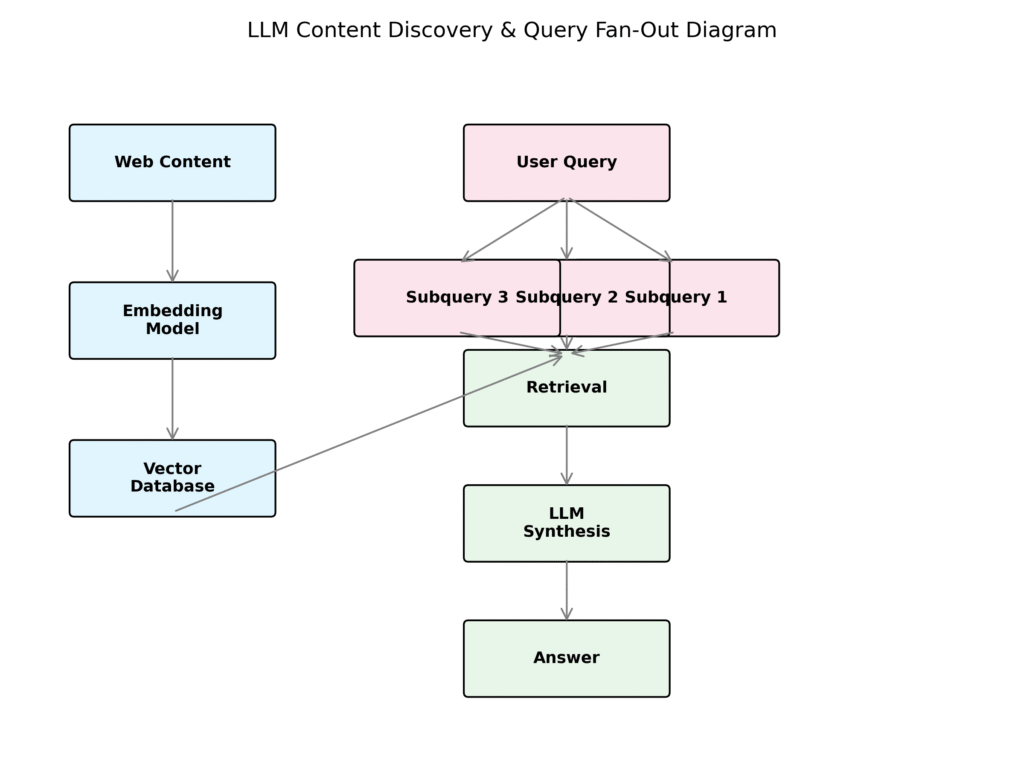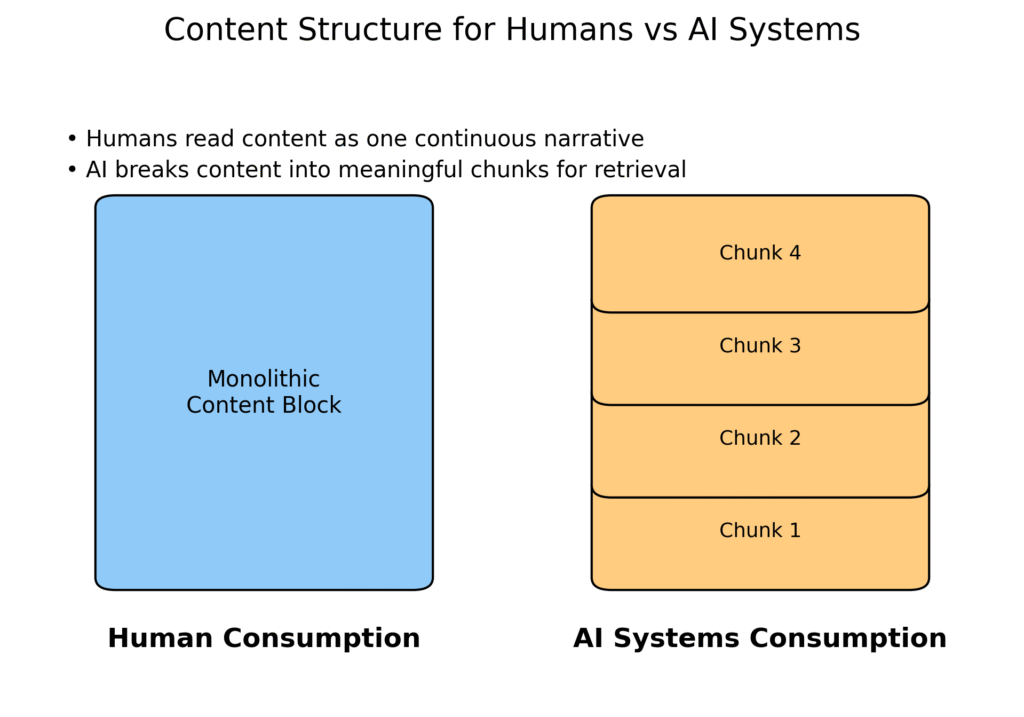How to Make Sure Your Website Wins Visibility in LLMs and AI Models
The rules of the game have changed. For over two decades, SEO professionals have optimised websites to climb the SERPs ladder, targeting keywords, building backlinks, and chasing the top-three positions. But we need to completely transform the way we’ve been reporting to clients and measuring success. Large Language Models like ChatGPT, Google’s AI Overviews, and AI-powered search engines are reshaping how brands build visibility and the KPIs they use to prove ROI.
It’s going to be a tough road. We’re going to have to manage expectations with key stakeholders and steer marketing teams away from measuring clicks and prioritising ‘keyword volume’ – something the industry has been doing for decades. But it presents a huge opportunity – the brands that win in AI search are going to be right in the thick of conversations happening directly with consumers; in a space where there are no huge lists of blue links, ads to scroll through or annoying blog posts to avoid. Here’s how we see things evolving as search behaviour is overhauled.
The Visibility Paradigm Shift
Traditional SEO operated on a simple premise: create content that search engines could crawl, index, and rank based on relevance signals. Success was measured in positions, click-through rates, and organic traffic. The goal was clear: get your blue link as high as possible on the results page. Simple, eh?
AI-driven search flips this model entirely. Large Language Models don’t crawl and rank like Google did; they comprehend, synthesise, and generate. They convert your content into high-dimensional mathematical representations called embeddings, store these in vector databases, and use sophisticated retrieval mechanisms to surface the most semantically relevant information for any given query. Simply put, this means they turn your words into mathematical codes that capture meaning, save these codes in databases, and use smart search systems to find the most relevant information when someone asks a question.
This means visibility in the AI era requires ensuring your content can be understood, contextualised, and retrieved by systems that analyse meaning at a deeper level than traditional search engines ever could. It’s a new layer of understanding and nuance that moves away from the idea that one blog post can give a person all of the answers they need on a topic. It’s like we had one teacher in the classroom – and now we have 8 – all answering the question from a different perspective.
The implications are pretty profound.
How LLMs Actually Discover Your Content
Understanding LLM visibility requires grasping how these systems process and represent information. Unlike traditional search engines that primarily match queries to indexed pages, LLMs employ a multi-layered approach to content discovery and retrieval.
The process begins with web crawling, often leveraging datasets like Common Crawl: massive repositories of web content that serve as training data for language models. Your content becomes part of this vast knowledge base, but only if it’s accessible and crawlable.
Once ingested, your content undergoes a transformation process. Text is converted into embeddings: numerical vectors that capture semantic meaning in high-dimensional space. These embeddings represent individual words while encoding relationships, context, and conceptual connections within your content.
The real magic happens during retrieval. When someone queries an AI system, it goes beyond keyword matches. Instead, it employs Retrieval-Augmented Generation (RAG), a process that searches through vector databases to find the most semantically relevant content chunks. These chunks are then used to generate comprehensive, contextual responses.
This system understands entities: people, places, concepts, and their relationships. It recognises when you’re discussing “Apple” the company versus “apple” the fruit, not just through capitalisation, but through contextual understanding of the surrounding content and semantic relationships.
What is Query Fan-Out and why is it important?

Perhaps the most significant difference between traditional search and AI-powered discovery lies in query processing. When you type a question into Google, the engine looks for pages that match your specific keywords and intent. When you ask an AI system, something far more sophisticated happens.
AI systems perform what’s known as ‘query fan-out‘: they process your exact question while simultaneously generating multiple related queries, expanded versions, and semantic variations of your original request. Each of these variations is then used to search through their vector database, pulling relevant content chunks that might answer different aspects of your query.
For example, if someone asks “How do I improve my website’s performance?”, an AI system might simultaneously search for content about page speed optimisation, user experience improvements, technical SEO, conversion rate optimisation, and website analytics. It then synthesises information from multiple sources to provide a comprehensive answer.
This means optimising for AI visibility is really about coverage across an entire semantic graph of your topic area. A great way to do this and make sure that you’re ICP led, then map out the user journey of each of your customer profiles step-by-step. Get detailed on their mind state, struggles, concerns, confusions, roadblocks – then map it out, conversation style. Build a brain bank of queries around that ICP and topical area – then serve the entire journey with your commercial landing pages, buyer guides and content.
Strategic Tactics for LLM Optimisation
Embrace Entity-Based Content Architecture
The foundation of AI visibility centres on entities. Entities are the people, places, things, and concepts that form the building blocks of knowledge. While traditional SEO focused on keywords, AI systems understand entities and their relationships.
Start by identifying the core entities in your industry. If you’re in e-commerce, your entities might include product categories, brands, customer types, and use cases. For each entity, ensure you’re providing comprehensive, authoritative information that establishes clear relationships and context.
Implement structured data markup using Schema.org vocabulary. When you mark up a product, person, or concept with structured data, you’re essentially providing a translation layer that helps AI systems categorise and understand your content more accurately.
Consistency across platforms becomes crucial. Ensure your entity representations align with established knowledge bases like Google’s Knowledge Graph and Wikidata. Inconsistent information confuses AI systems and reduces your content’s reliability score in their decision-making processes.
Master Content Chunking and Modular Design

AI systems break down content into discrete, meaningful chunks that can be independently understood and retrieved. This requires a fundamental shift in how we structure content.
You need to design your content as a series of self-contained modules. Each section should be able to stand alone while contributing to the larger narrative. Use semantic HTML properly: your H2 and H3 tags should function as structural signals that help AI systems understand content organisation.
Every chunk should address a question, concept, or subtopic. Think of each section as a potential answer that might be extracted and used in isolation. This means avoiding vague references to “the above section” or “as mentioned earlier.” Each chunk needs to be contextually complete. It also means that your headings have to make sense as stand alone pieces of content – if your main blog title is ‘Drink Driving Laws All Around the World’ and then your subheadings are “Speeding” or “England” – ask yourself whether those headings make sense without the context of the rest of the article. In this example – they don’t. So you’d want to change them to “Speed Limits Across Europe” and “Drink Driving Laws in England”.
You should also think about implementing FAQ sections, comparison tables, and step-by-step guides. These formats naturally create the kind of structured, retrievable content chunks that AI systems are really good at utilising.
Build Comprehensive Topical Authority
AI systems favour comprehensive coverage of a topic. This goes beyond the traditional “pillar page and cluster” approach: you need to think in terms of knowledge graphs and semantic completeness.
Map out your topic’s entire semantic universe. What are the core concepts? What are the related subtopics? What questions do people ask? What comparisons do they make? Your content strategy should systematically address each of these areas.
Create interconnected content hubs that thoroughly explore every facet of your domain. If you’re covering digital marketing, don’t simply write about SEO, PPC, and social media in isolation. Explore how they connect, where they overlap, and how they work together. AI systems understand and value these conceptual relationships.
Internal linking becomes even more critical in this context. Your internal links help create semantic pathways that help AI systems understand the relationships between your content pieces. Every internal link is a signal about how concepts relate to each other within your knowledge domain.
Optimise Technical Accessibility for AI Crawling
While the processing mechanisms have evolved, the fundamental requirement for content accessibility remains. AI systems, particularly those using web crawling for training data, need to be able to discover and access your content.
Ensure your robots.txt file isn’t blocking important content. Review your sitemap structure to make sure it accurately represents your content hierarchy. Page speed and mobile optimisation remain important: not just for user experience, but for comprehensive content indexing.
Consider the formats AI systems can process. While they’re getting better at understanding multimedia content, text remains the most reliably processed format. Ensure important information isn’t locked away in images, videos, or PDFs without accompanying text descriptions.
Engineer Content for Direct Answer Extraction
AI systems excel at providing direct and detailed answers to nuanced questions. This mirrors the featured snippet optimisation strategies we’ve used in traditional SEO, but with more importance and sophistication.
Structure your content to answer questions directly and concisely. Lead with the answer, then provide supporting context and detail. Use formatting that makes key information easily extractable: bullet points, numbered lists, tables, and clear hierarchical organisation.
Consider creating dedicated Q&A sections that address common questions in your industry. These serve dual purposes: they provide immediate value to human readers while creating perfectly formatted content for AI extraction and synthesis.
How Do You Measure GEO Succes?
One of the biggest challenges for brands and agencies is about measurement; there’s no ‘AI Console’ equivalent to Google Search Console, no direct way to track your “vector ranking” or “embedding performance.”
However, we can employ several proxy methods to gauge our AI visibility. We use a range of tools for measuring AI visibility, including Peec AI and LLMrefs, which help track our client’s visibility across specific query sets and give us an idea of our overall LLM answer visibility.
You should also consider implementing tracking for AI referral traffic. You can set u a custom report in GA4 or integrate the data into a Looker Studio report like we do.
Another option, mainly for enterprise brands, is to create your own custom AI visibility tracking dashboard which gives you ownership over comprehensive GEO measurement data. Custom solutions can track AI Overview performance, monitor brand presence across multiple AI models, and provide competitive positioning insights.
For large organisations managing multiple brands or markets, purpose-built dashboards can give your team the strategic intelligence needed to maintain competitive advantage in AI-driven search environments. Plus, you can often make a cost saving in the long run, as third party tracking tools can be quite pricey as you begin tracking queries in high numbers. By getting your own tool made, you’re essentially paying the monthly fee without the SaaS tool’s markup.
The LLM Optimisation Checklist
Entity and Semantic Optimisation:
- Identify and consistently define key entities in your content
- Implement comprehensive Schema.org markup
- Ensure entity consistency across platforms and knowledge bases
- Map relationships between entities in your domain (internal linking)
Content Structure and Chunking:
- Break content into self-contained, meaningful sections
- Use semantic HTML structure properly
- Create FAQ sections and structured Q&A content
- Ensure each content chunk can stand alone contextually
Topical Coverage and Authority:
- Map comprehensive coverage of your topic’s semantic universe
- Create interconnected content hubs addressing all relevant subtopics
- Build robust internal linking reflecting semantic relationships
- Address related concepts, comparisons, and use cases thoroughly
Technical Accessibility:
- Ensure proper crawlability and indexability
- Maintain updated, structured sitemaps
- Optimise for multiple content formats while prioritising text
- Remove technical barriers to content access
AI-Ready Formatting:
- Lead with direct answers to common questions
- Use extractable formatting like lists, tables, and clear hierarchies
- Create content that works for both humans and AI synthesis
- Test content with AI systems to verify understanding and retrieval
How can Didgeheads help with your GEO?
Optimising for AI‑driven search requires a structured, data‑driven approach. That’s why Didgeheads offers a dedicated GEO Audit designed to make your content AI‑visible, AI‑credible and AI‑citable.
Our audit evaluates how AI platforms such as Google’s AI Overviews, ChatGPT, Claude and Perplexity interpret and retrieve your content. We look at everything from chunk optimisation, to trust signals, authoritativeness and multimedia discoverability. You’ll receive a comprehensive report with clear, prioritised recommendations and a recorded walkthrough within two weeks.
Once the audit is complete, we can support you with ongoing GEO work, helping you implement the roadmap, refine your entity and topic coverage, and monitor performance through our proprietary AI tracking dashboard. Our goal is to give your team the insights and tools to stay ahead as AI search evolves, rather than sell you a one‑off fix.
You can also take our 3 minute quiz to understand which areas of your SEO strategy you need to prioritise. It’s free!
assess your seo performance level


